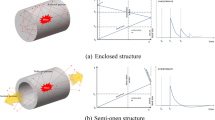Abstract
Some characteristics of interior explosions within a cabin structure with a venting hole are investigated. It may simulate a warhead explosion inside a cabin following its penetration through the cabin wall. The study includes both experimental and theoretical analyses of the problem. The experimental investigation comprises of two types of explosives at the center of the cabin. The pressure distributions at different locations on the cabin wall are obtained. The effect of internal shock reflection is analyzed by using the method of images (MOI). It is found that the geometric symmetries can cause the multiple reflected shocks to converge with strength comparable to the initial free shock.
Similar content being viewed by others
References
Hu Y, Wu C Q, Lukaszewicz M, et al. Characteristics of confined blast loading in unvented structures [J]. International Journal of Protective Structures, 2011, 2(1): 21–44.
Edri I, Savir Z, Feldgun V R, et al. On blast pressure analysis due to a partially confined explosion. I. Experimental studies [J]. International Journal of Protective Structures, 2011, 2(1): 1–20.
Anderson C E, Baker J W E, Wauters D K, et al. Quasi-static pressure, duration, and impulse for explosions (e.g. HE) in structures [J]. International Journal of Mechanical Sciences, 1983, 25(6): 455–464.
Benselama A M, William-Louis M J P, Monnoyer F. A 1D-3D mixed method for the numerical simulation of blast waves in confined geometries [J]. Journal of Computational Physics, 2009, 228(18): 6796–6810.
Feldgun V R, Karinski Y S, Yankelevsky D Z. A simplified model with lumped parameters for explosion venting simulation [J]. International Journal of Impact Engineering, 2011, 38(12): 964–975.
Baker W E, Westine P S. Methods of predicting blast loads inside and blast fields outside suppressive structure [R]. Texas: Southwest Research Institute, 1975.
Esparza E D, Baker W E, Oldham G A. Blast pressure inside and outside suppressive structure [R]. Texas: Southwest Research Institute, 1975.
Ferrara G, Benedetto A D, Salzano E, et al. CFD analysis of gas explosions vented through relief pipes [J]. Journal of Hazardous Materials, 2006, 137(2): 654–665.
Rigas F, Sklavounos S. Experimentally validated 3-D simulation of shock waves generated by dense explosives in confined complex geometries [J]. Journal of Hazardous Materials, 2005, 121(1): 23–30.
Chan P C, Klein H H. A study of blast effects inside an enclosure [J]. Journal of Fluids Engineering, 1994, 116(3): 450–455.
Zyskowski A, Sochet I, Mavrot G, et al. Study of the explosion process in a small scale experiment — structural loading [J]. Journal of Loss Prevention in the Process Industries, 2004, 17(4): 291–299.
Janovsky B, Selesovsky P, Horkel J, et al. Vented confined explosions in stramberk experimental mine and AutoReaGas simulation [J]. Journal of Loss Prevention in the Process Industries, 2006, 19(2–3): 280–287.
Qiao Xiao-ling, Hu Yi-ting, Peng Jin-hua, et al. TNT equivalence of a rock emulsion explosive [J]. Explosive Materials, 1998, 27(6): 5–8 (in Chinese).
Deng Gui-de, Zheng Jin-yang, Chen Yong-jun, et al. Near-field blast loadings from explosion of two typically shaped charges [J]. Journal of PLA University of Science and Technology: Natural Science Edition, 2010, 11(4): 462–467 (in Chinese).
Lam N, Mendis P, Ngo T. Response spectrum solutions for blast loading [J]. Electronic Journal of Structural Engineering, 2004, 4: 27–44.
Smith P D, Mays G C, Rose T A, et al. Small scale models of complex geometry for blast overpressure assessment [J]. International Journal of Impact Engineering, 1992, 12(3): 345–360.
Author information
Authors and Affiliations
Corresponding author
Additional information
Foundation item: the Defense Industrial Technology Development Program (No. A1420080184) and the Fundamental Research Funds for the Central Universities of China (No. 2011YB08)
Rights and permissions
About this article
Cite this article
Kong, Xs., Wu, Wg., Li, J. et al. Experimental investigation on characteristics of blast load in partially confined cabin structure. J. Shanghai Jiaotong Univ. (Sci.) 18, 583–589 (2013). https://doi.org/10.1007/s12204-013-1431-0
Received:
Published:
Issue Date:
DOI: https://doi.org/10.1007/s12204-013-1431-0




